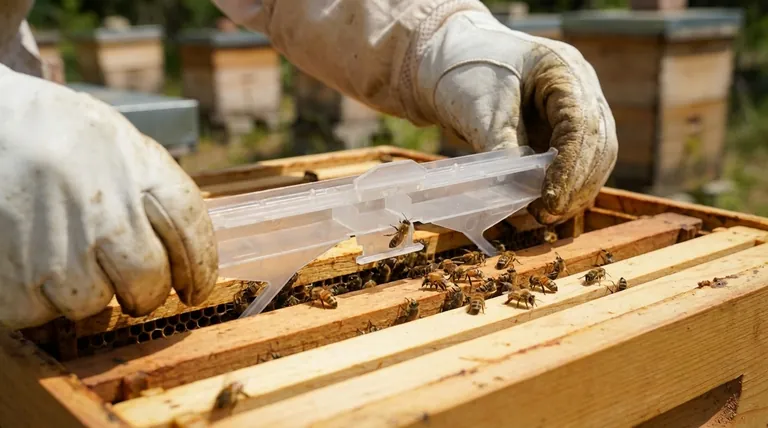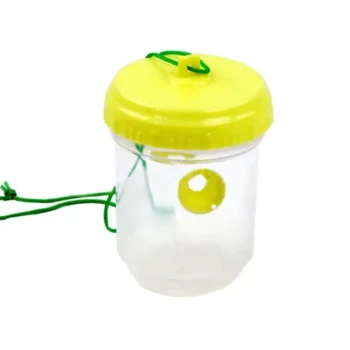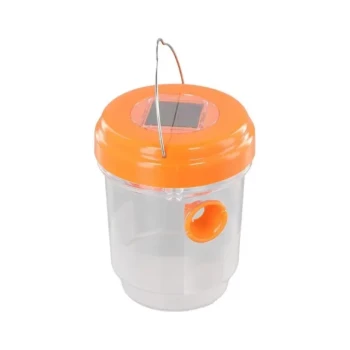At its core, hive beetle traps are a critical tool for beekeepers because they actively control the small hive beetle population within a colony. By capturing and killing these invasive pests, traps prevent the beetles from reproducing and causing significant harm, which is essential for keeping a beehive both healthy and productive.
The small hive beetle is a mobile, invasive pest that can quickly overwhelm a honey bee colony. Hive beetle traps are not just a tool; they are a beekeeper's primary proactive defense, designed to neutralize the threat before it escalates into a catastrophic infestation.

The Nature of the Hive Beetle Threat
An Invasive Pest
The small hive beetle is an invasive pest that can devastate a honey bee colony. Originally from sub-Saharan Africa, they have spread globally and present a serious challenge for beekeepers.
These beetles are highly adaptable and reproduce quickly within the warm, food-rich environment of a beehive.
How Beetles Damage a Colony
Adult beetles themselves are a nuisance, but the primary damage is done by their larvae. The larvae tunnel through comb, eating honey, pollen, and bee brood.
As they feed, they defecate in the honey, introducing yeast that causes it to ferment and run out of the cells. This foul, slimed honey is ruined for both the bees and the beekeeper, and a severe infestation can drive the entire bee colony to abscond, abandoning the hive completely.
The Challenge of Rapid Spread
Adult hive beetles can fly several miles, allowing them to easily move from a weak, infested hive to a strong, healthy one.
This mobility means that a beetle problem in one hive can quickly become an apiary-wide crisis. A single unmanaged colony can serve as a breeding ground that threatens every other hive in the area.
How Traps Function as a Core Defense
The Principle of Interception
Most hive beetle traps work by exploiting the beetles' natural behavior. Beetles seek dark, tight spaces to hide from bees, which constantly harass and try to corral them.
Traps provide these ideal hiding spots but contain oil, diatomaceous earth, or a sticky surface that captures and kills the beetles when they enter. They are a form of targeted, passive pest control inside the hive.
A Proactive Management Tool
Hive beetle traps are a proactive measure, not a reactive one. By placing them in the hive before beetle numbers get high, you constantly reduce the pest population.
This prevents the beetles from reaching a critical mass where their reproduction outpaces the bees' ability to manage them, thereby averting a full-blown infestation.
Protecting Hive Health and Productivity
By keeping beetle populations low, traps directly protect the colony's resources. The bees do not have to waste energy and resources chasing beetles, the brood is safe from being consumed, and the honey remains pure.
This ensures the colony can focus on its primary tasks: raising young bees, foraging for nectar, and producing honey.
Understanding the Limitations and Realities
Traps Are a Tool, Not a Cure
It is crucial to understand that traps are for control, not eradication. You will likely never eliminate every single beetle from your apiary.
Their purpose is to keep the beetle population at a level so low that it does not harm the hive. They are one component of a larger Integrated Pest Management (IPM) strategy.
The Need for Consistent Maintenance
Hive beetle traps are not a "set it and forget it" solution. They must be regularly inspected, cleaned, and refilled or replaced.
A full or neglected trap is ineffective. This simple maintenance is a key part of responsible hive management and ensures your primary defense remains active.
Strong Colonies Are the Best Defense
Traps are most effective when supporting a strong, healthy, and populous bee colony. A large population of bees can police the hive effectively, chasing beetles and keeping them contained.
Traps assist these strong colonies and provide critical support to weaker colonies that are more vulnerable to being overwhelmed.
Making the Right Choice for Your Goal
Integrating traps is a fundamental step in modern beekeeping. Your specific goal will determine how you prioritize their use.
- If your primary focus is preventing infestation in a healthy hive: Use traps as a constant monitoring tool and first line of defense, keeping beetle numbers negligible from the start.
- If your primary focus is managing an existing problem: Combine multiple, well-maintained traps with efforts to boost colony strength, such as combining weaker hives or reducing entrance size.
- If your primary focus is reducing hive disruptions: Regularly checking and maintaining traps can give you a clear picture of pest pressure, potentially reducing the need for more frequent, full-frame inspections.
Ultimately, using hive beetle traps empowers you to actively defend your bees from one of their most persistent threats.
Summary Table:
| Key Aspect | Why It Matters |
|---|---|
| Primary Function | Actively controls small hive beetle populations by capturing and killing them. |
| Threat Mitigated | Prevents larvae from destroying comb, fermenting honey, and causing colony absconding. |
| Management Role | A proactive tool within an Integrated Pest Management (IPM) strategy. |
| Critical for | Protecting hive health, productivity, and the beekeeper's honey harvest. |
Protect Your Apiary's Productivity and Health
A small hive beetle infestation can quickly undo months of hard work and investment. Don't leave your colonies vulnerable. HONESTBEE supplies commercial apiaries and beekeeping equipment distributors with the reliable, high-quality pest control tools needed for effective hive management.
Contact our experts today to discuss wholesale pricing on hive beetle traps and other essential equipment. Let us help you build a stronger, more resilient beekeeping operation.
Visual Guide

Related Products
- Reusable Clear Small Hive Beetle Traps for Beehives Beetle Trapping Tools
- Reusable Aluminium Beetle Trap for Small Hive Beetles Silver Bullet
- Black Plastic Beetle Barn Hive Beetle Trap for Beehives
- Removable Washable Hive Beetle Trap Attractants for Small Hive Beetles
- Plastic Beetle Blaster Trap Beekeeping Tools and Supplies
People Also Ask
- How do Beetle Blasters trap adult beetles? A Simple, Non-Chemical Pest Control Solution
- What is the best time to use beetle traps? Master the Spring Strategy for Effective Hive Protection
- What are the advantages of handheld beetle blasters and traps? Simple, Chemical-Free Hive Protection
- How should filled beetle traps be handled? Safely Remove and Dispose to Protect Your Hive
- How do hive beetle traps work? A Beekeeper's Guide to Non-Chemical Control



















